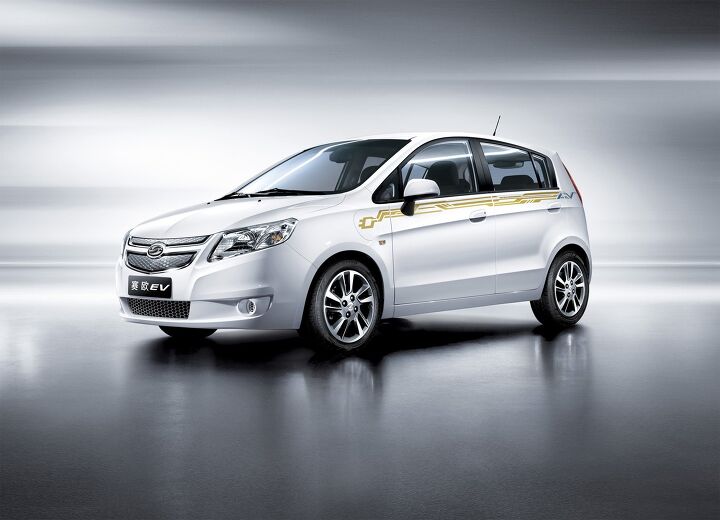GM Launches Chinese EV Under "Shanghai GM" Brand

That GM will launch an electrified Sail in China is no secret, at least not to TTAC readers. You won’t be surprised to hear that GM launched one at the Guangzhou auto show. The car is not the interesting part. The interesting part is the brand behind the car.
The car is called the Sail SPRINGO EV. Just like the Chevrolet Sail, the Sail SPRINGO EV is a purely Chinese development. It was designed by GM China’s Pan-Asia Technical Automotive Center (PATAC), and it is built by the Shanghai GM joint venture. But it is no Chevrolet.
The big surprise is the brand behind the Sail SPRINGO EV. According to the press release, the brand is “Shanghai GM.” To those with branding experience, this is a revolution. Normally, GM is a corporate entity and not a brand. Nowhere in the world can you buy a GM car, you need to buy a Chevrolet, or Buick, a Cadillac, Vauxhall, Holden, or Opel.
The choice of “Shanghai GM” as the brand for the EV is even more interesting considering that the Chinese government requests (or at least strongly recommends) that EVs are sold under a Chinese brand, if they want to qualify for subsidies and if its makers want to remain in the good graces of the Chinese government. All EVs developed by Chinese/Foreign joint ventures are sold under a new “Chinese” brand, owned by the joint venture. Nissan for instance has been on record that the Nissan Leaf will be made and sold under the Venucia brand, something Nissan reconfirmed yesterday to Reuters.
Apparently, Shanghai GM’s new Chinese brand is “Shanghai GM” – an unorthodox choice that flies in the face of all corporate identity rules, but a smart choice. New brands face a long uphill battle for name recognition and branding power, Shanghai GM won’t have that problem. The Sail SPRINGO EV had vexed observers with a new badge that looks like a stylized S, fuelling speculations that “Springo” could be the new electric vehicle brand. But then, that badge could also be an S and a G, for Shanghai GM …
The Shanghai GM Sail SPRINGO EV initially will be available in Shanghai only at a somewhat rich price of 258,000 RMB, or $41,500. Nevertheless, the car’s success is pretty much preordained. The car qualifies for a total of 100,000 RMB ($16,000) in incentives from the central government and the city of Shanghai. What’s more, the car comes with a free Shanghai license plate, something Shanghainese must pay up to $10,000 for. More than 60 percent of the car’s price is therefore covered by government incentives.
Driving the car is likewise a steal. Charging the car (7 hours off a standard 220 V socket) translates into a cost of 70 cents U.S. for 100 km (62 miles). The car is said to have a real-life range of 130 km (80 miles), and a maximum range of 200km (124 miles) under ideal conditions – perfect for a mega-city that measures less than 80 miles end to end. It also could turn into the ideal car to bring its owner to a real big car that is tagged and parked in one of the adjoining provinces.

Bertel Schmitt comes back to journalism after taking a 35 year break in advertising and marketing. He ran and owned advertising agencies in Duesseldorf, Germany, and New York City. Volkswagen A.G. was Bertel's most important corporate account. Schmitt's advertising and marketing career touched many corners of the industry with a special focus on automotive products and services. Since 2004, he lives in Japan and China with his wife <a href="http://www.tomokoandbertel.com"> Tomoko </a>. Bertel Schmitt is a founding board member of the <a href="http://www.offshoresuperseries.com"> Offshore Super Series </a>, an American offshore powerboat racing organization. He is co-owner of the racing team Typhoon.
More by Bertel Schmitt
Latest Car Reviews
Read moreLatest Product Reviews
Read moreRecent Comments
- ToolGuy TG likes price reductions.
- ToolGuy I could go for a Mustang with a Subaru powertrain. (Maybe some additional ground clearance.)
- ToolGuy Does Tim Healey care about TTAC? 😉
- ToolGuy I am slashing my food budget by 1%.
- ToolGuy TG grows skeptical about his government protecting him from bad decisions.





































Comments
Join the conversation
Meanwhile, that little fender square is VERBOTEN on all models.
The Chinese government is providing incentives and tax breaks to EV manufacturers is no surprise. In their smog- choked mega cities, it is a matter of survival, literally. And once that they develop these vehicles enough to make them competitive with ICE powered vehicles, they will start exporting them to the similar megalopolis, from Sao Paulo to Mumbai.